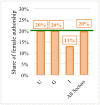On the Compliance of Women Engineers with a Gendered Scientific System
- PMID: 26716831
- PMCID: PMC4696668
- DOI: 10.1371/journal.pone.0145931
On the Compliance of Women Engineers with a Gendered Scientific System
Abstract
There has been considerable effort in the last decade to increase the participation of women in engineering through various policies. However, there has been little empirical research on gender disparities in engineering which help underpin the effective preparation, co-ordination, and implementation of the science and technology (S&T) policies. This article aims to present a comprehensive gendered analysis of engineering publications across different specialties and provide a cross-gender analysis of research output and scientific impact of engineering researchers in academic, governmental, and industrial sectors. For this purpose, 679,338 engineering articles published from 2008 to 2013 are extracted from the Web of Science database and 974,837 authorships are analyzed. The structures of co-authorship collaboration networks in different engineering disciplines are examined, highlighting the role of female scientists in the diffusion of knowledge. The findings reveal that men dominate 80% of all the scientific production in engineering. Women engineers publish their papers in journals with higher Impact Factors than their male peers, but their work receives lower recognition (fewer citations) from the scientific community. Engineers-regardless of their gender-contribute to the reproduction of the male-dominated scientific structures through forming and repeating their collaborations predominantly with men. The results of this study call for integration of data driven gender-related policies in existing S&T discourse.
Conflict of interest statement
Figures











References
-
- Godin B. The knowledge-based economy: Conceptual framework or buzzword? J Technol Transf. 2006;31: 17–30. 10.1007/s10961-005-5010-x - DOI
-
- OECD. The Knowledge-based Economy [Internet]. Paris: OECD; 1996. Available: http://www.oecd.org/sti/sci-tech/1913021.pdf
-
- Schumpeter JA. The theory of economic development: An inquiry into profits, capital, credit, interest, and the business cycle [Internet]. Transaction Publishers; 1934.
-
- Solow RM. A contribution to the theory of economic growth. Q J Econ. 1956;70: 65–94.
Publication types
MeSH terms
LinkOut - more resources
Full Text Sources
Other Literature Sources
Medical
Miscellaneous

